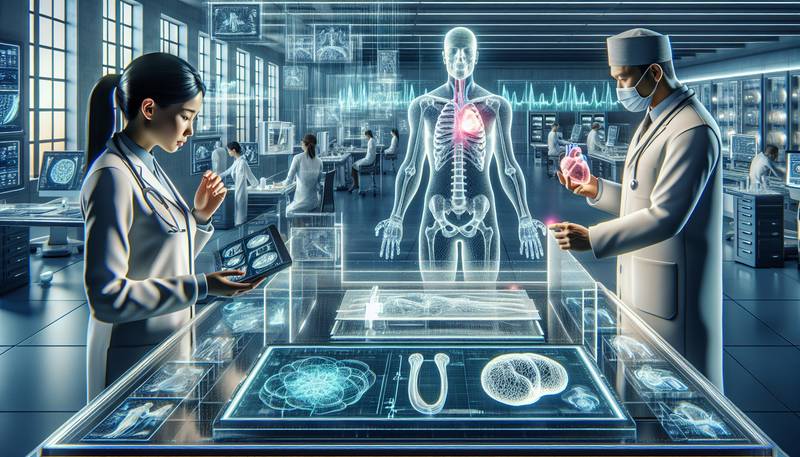3D Printing in Medicine: Revolutionizing Prosthetics and Paving the Way for Organ Transplants

Introduction to 3D Printing in Medicine
3D printing, or additive manufacturing, has been a game-changer in various industries, but its impact on medicine has been transformative. The technology allows for the creation of complex and intricate structures, making it perfect for customizing medical equipment, aids, and even human tissues. In this article, we will explore the diverse applications of 3D printing in medicine, from prosthetics to the exciting prospects of organ transplants.
The Revolution of Prosthetics
Prosthetics have been around for centuries, but traditional manufacturing methods limited their customization and comfort. Enter 3D printing, and the scenario changes entirely. With the ability to tailor-make prosthetics to fit the unique contours of an individual's residual limb, patients can now enjoy improved comfort and mobility. Additionally, the speed at which these prosthetics can be manufactured means that patients no longer have to wait months for their custom prosthetic. Instead, they can receive it within days, sometimes even hours.
But it's not just the speed and customization that make 3D-printed prosthetics revolutionary. The cost factor plays a significant role too. Traditional prosthetics can be prohibitively expensive, but 3D printing has slashed prices, making them more accessible to a broader demographic. It's a win-win for both patients and the healthcare system.
Innovations in Medical Devices and Surgical Tools
3D printing has also made waves in the creation of medical devices and surgical tools. Custom surgical instruments, tailored to a surgeon’s hand, can provide greater precision and comfort during operations. This customization can lead to shorter surgery times and improved outcomes for patients. Moreover, 3D-printed medical devices, such as hearing aids, dental implants, and orthopedic implants, can be tailored to match the patient's anatomy, leading to a better fit and function.
Case Study: The 3D-printed Heart Valve
A notable success story is the 3D-printed heart valve, which can be tailored to fit the unique anatomical features of a patient's heart. This customized approach has seen improved patient outcomes and fewer complications during and after surgery.
The Frontier of Bioprinting: Towards Organ Transplants
Perhaps the most exciting development in 3D printing within medicine is bioprinting – the process of creating living tissues and organs. This breakthrough technology is at the forefront of solving the organ shortage crisis. By using a patient's cells to print organs, the risk of rejection is drastically reduced, and the long wait for a donor organ could be a thing of the past.
The Process of Bioprinting
Bioprinting involves several steps, starting with the creation of bio-inks, which are made of living cells. These bio-inks are then used by the 3D printer to layer-by-layer create the desired tissue or organ. It's a delicate process that mimics the natural tissue formation but at an accelerated pace.
Challenges and Future Prospects
While the prospects are exciting, bioprinting is not without its challenges. Replicating the complex structures of organs, ensuring they function correctly, and integrating them into the human body are hurdles that researchers are still working to overcome. However, the potential is immense, and with continuous advancements, the first fully functional 3D-printed organ transplant may not be far away.
The Role of 3D Printing in Medical Training and Education
Another fascinating application of 3D printing in medicine is in the realm of medical training. Medical students and professionals can now practice surgeries and procedures on 3D-printed models that replicate human anatomy accurately. This hands-on experience provides a risk-free environment, enhancing the learning process and preparing future doctors for real-life scenarios more effectively.
Impact on Developing Countries
Developing countries, where access to medical training and equipment may be limited, stand to benefit significantly from 3D printing. Low-cost training models and medical devices, readily manufacturable on-site, can revolutionize healthcare in these regions, providing better care and improving outcomes.
3D Printing: A Catalyst for Personalized Medicine
At its core, 3D printing is propelling medicine towards a more personalized approach. Instead of relying on standardized equipment and devices, 3D printing allows for medicine tailored to the individual. The result is a healthcare system that is not only more efficient but one that provides better care, improved outcomes, and, ultimately, a higher quality of life for patients.
Conclusion: The Future is 3D Printed
In conclusion, 3D printing in medicine is not just a fleeting trend; it's the future. From revolutionizing prosthetics and customizing medical devices to the promising horizon of organ transplants, the technology is poised to make a significant impact. While there are challenges to be met, the intersection of technology and healthcare is an exciting space, filled with possibilities that were once deemed the stuff of science fiction. 3D printing is set to make these possibilities a reality, and in doing so, redefine what is achievable in medicine.
Final Thoughts
As 3D printing technology continues to advance, we can only imagine the myriad ways it will further innovate the medical field. The potential for growth is tremendous, and we stand on the cusp of a new era in healthcare – an era marked by personalization, accessibility, and groundbreaking achievements. The journey from prosthetics to organ transplants is just the beginning. The future of 3D printing in medicine is bright, and it's an exciting time to be part of this evolution.


